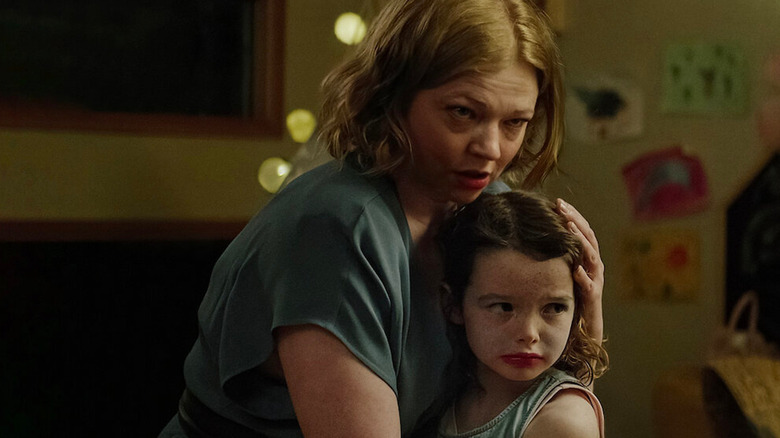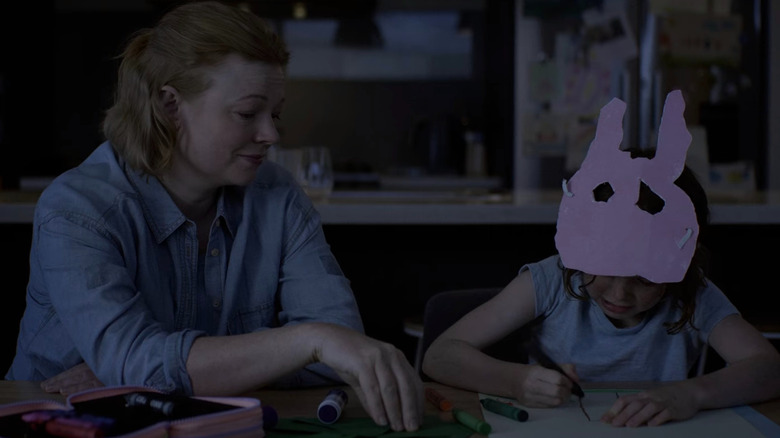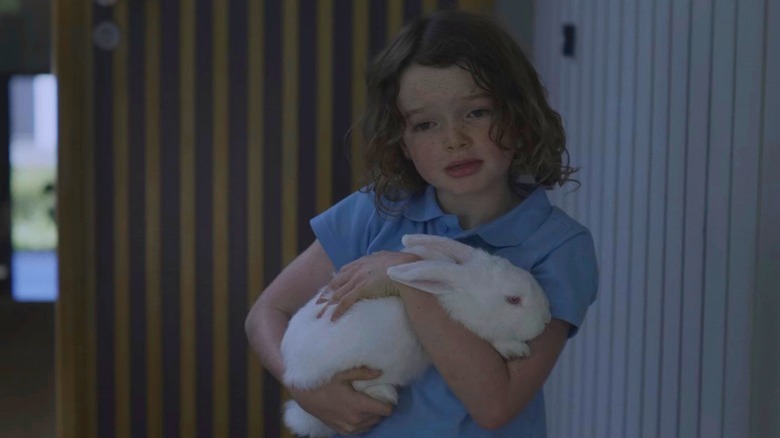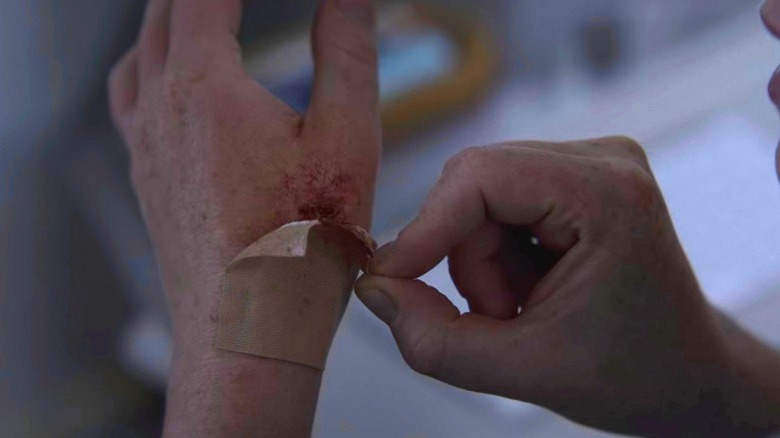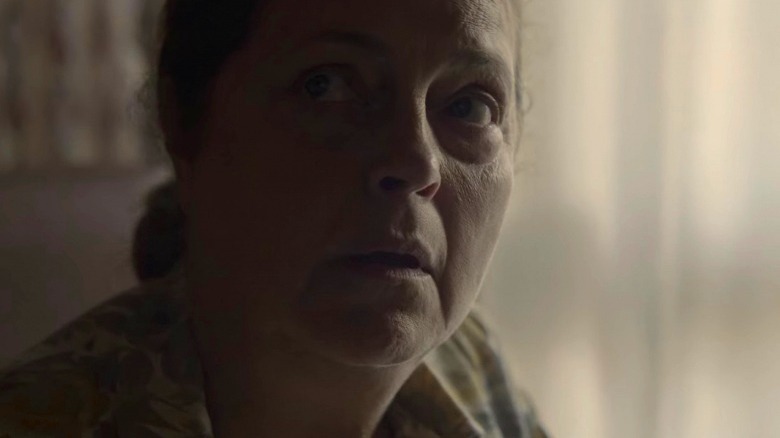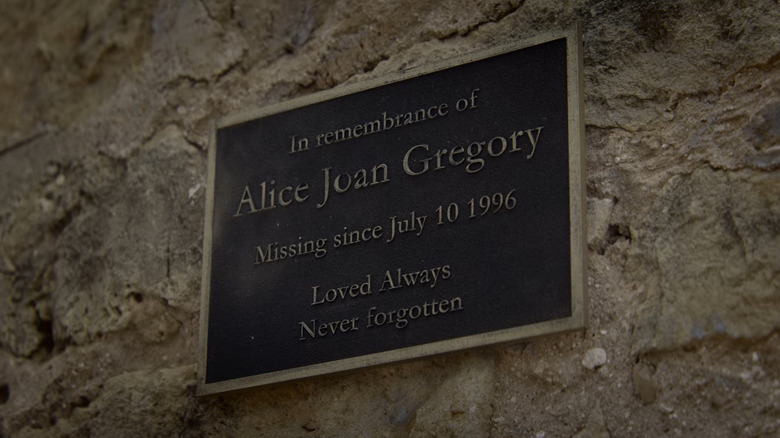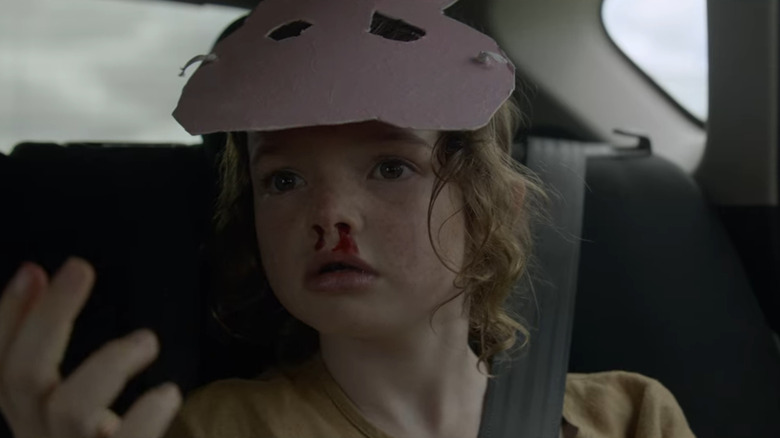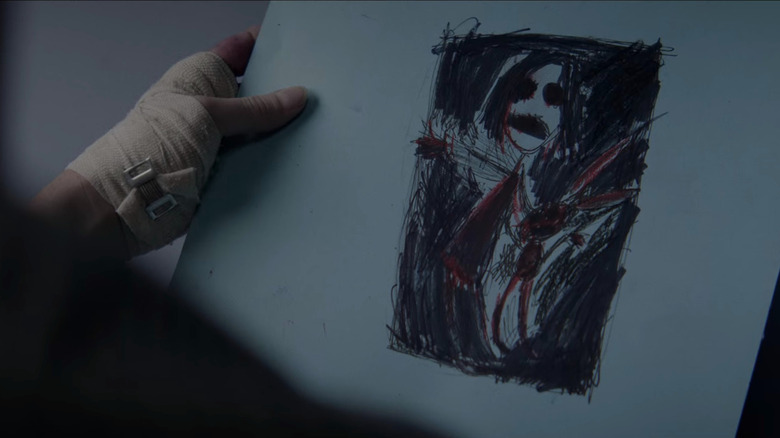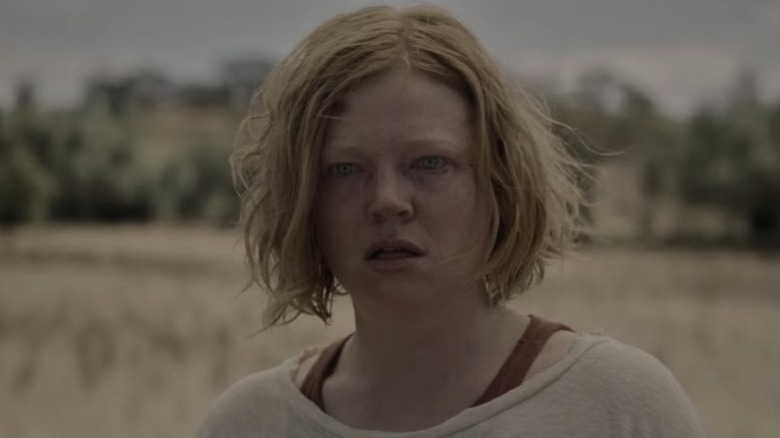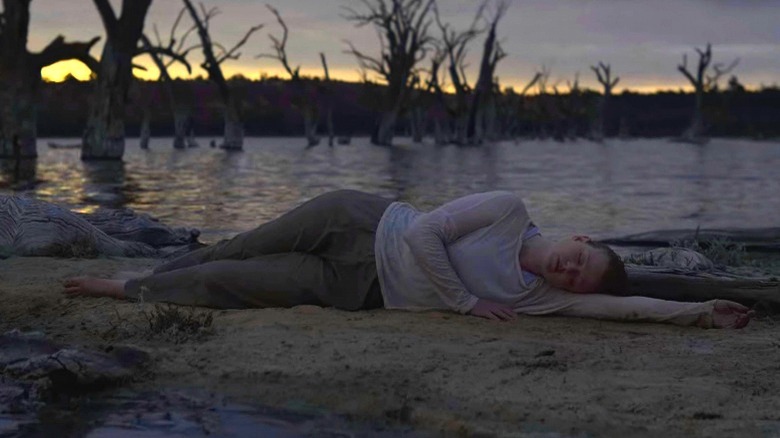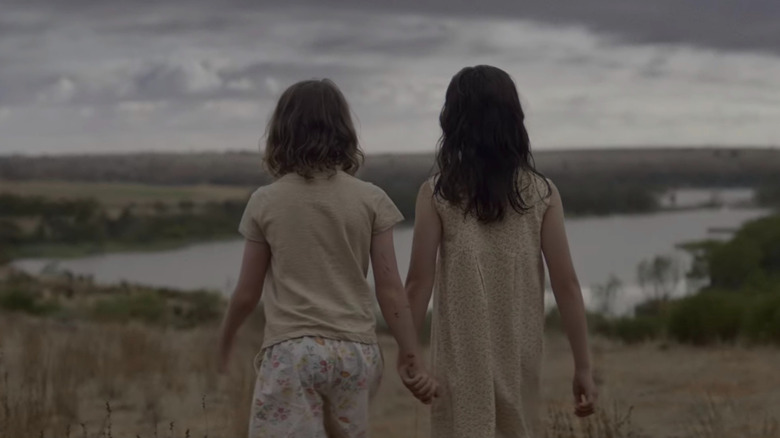The Ending Of Run Rabbit Run Explained
Contains spoilers for "Run Rabbit Run"
"Run Rabbit Run," released in 2023, is yet another addition to Netflix's ever-growing catalog of horror films, right alongside the likes of the "Fear Street" trilogy. Upon first inspection, "Run Rabbit Run" draws a few notable similarities with Jennifer Kent's "The Babadook" and not solely because of their shared Australian setting. Both films take a look at a strained relationship between mother and child, albeit through different supernatural circumstances.
The film is undoubtedly a slow burn, taking ample time to immerse its viewers in its uncomfortable and increasingly disturbing circumstances. Whereas many modern horror films go for high-concept visuals or even grand supernatural threats, this one is far more subdued in its execution. It's a film that'll definitely reward its viewers for paying ample attention as it weaves its tangled web of disturbing revelations.
However, it is worth focusing on the film's ending, a conclusion that might leave a few viewers a little bit mystified. So grab your homemade rabbit mask and hold on tight — this is the ending of "Run Rabbit Run" explained.
What you need to remember about the plot of Run Rabbit Run
From its opening scene, "Run Rabbit Run" sets the tone that'll be persistent throughout the entire film – doom and ample amounts of gloom. When we first see our protagonist Sarah (Sarah Snook), we're shown what seems to be a haunting vision or potentially a premonition of her in a grisly marsh. This proves, at first, to be nothing more than a dream, and we're then thrust into Sarah's daily life as a fertility doctor. We're also introduced to Mia (Lily LaTorre), Sarah's daughter, with whom she seems to have a very healthy and loving relationship.
However, we quickly learn that one person Sarah doesn't have a good relationship with is her mother, Joan (Greta Scacchi), whom she seems resistant to visiting at assisted living. Things then take a turn for the creepy when a lone rabbit turns up in Sarah's home, which Mia quickly becomes smitten with. Following this, Mia begins wearing a crude paper rabbit mask, as well as becoming increasingly socially distant and emotionally short with her mother.
This all happens not long after the passing of Sarah's father, with Sarah also hesitant to unpack, both literally and figuratively, her family's past. Things get even weirder when Mia seems to abandon her true identity and begins calling herself Alice, the name of Sarah's long-missing sister. There's much more to unpack and analyze in "Run Rabbit Run," but these are the key points that help set the stage for the film's sinister events.
The significance of the rabbit and rabbit mask
The first major thing to unpack in regard to "Run Rabbit Run" is the titular rabbit, as well as the rabbit mask worn by Mia. Shortly after the rabbit appears in their home, both Sarah and Mia begin acting differently — especially Mia, who begins showing signs of supernatural influence. She begins wearing the rabbit mask whenever possible and begins referring to herself as Alice, Sarah's sister. In addition, she keeps demanding to see Joan, Sarah's mother, who is currently declining mentally due to a dementia diagnosis.
But what does this have to do with rabbits? Quite a few things, actually, especially when we begin learning more about Sarah's childhood. The more Mia pries into Sarah's past, the more Sarah relents and begins to elaborate, starting with her recently deceased father. We learn that her father was a good man with an affinity for catching wild rabbits, giving us our first obvious connection within the film's text. This might be a possible explanation for why it's eventually revealed that Sarah's father constantly abused and locked Sarah away during their childhood, much like a wild rabbit.
Rabbits are an oft-used device in horror films. A recent example is Jordan Peele's "Us," in which the film uses rabbits as a visual representation of the Tethered. One can also make the case that the rabbit presented here is a twisted version of an emotional support animal, a role that rabbits often fill in real life.
If you or someone you know may be the victim of child abuse, please contact the Childhelp National Child Abuse Hotline at 1-800-4-A-Child (1-800-422-4453) or contact their live chat services.
The infected rabbit bite
"Run Rabbit Run" is full of a few subtle touches that contribute to its overall theme, and the rabbit bite Sarah receives early in the film is certainly a more grisly one. Continuing with the ideas surrounding the rabbit for a bit longer, let's address that bite. After Mia and Sarah find the rabbit in their house, Mia is immediately receptive to it, while Sarah is more put off than anything else. Just how this rabbit found its way into their house is never actually explained, though we can surmise its origins to be supernatural.
While Mia adores the fuzzy little creature, Sarah is far less enthusiastic, especially after it bites her as she tries to shoo it away. This bite remains for the rest of "Run Rabbit Run," never seeming to heal and becoming increasingly more infected as time goes by. However, regardless of just how infected her bite becomes, Sarah never addresses it with anyone or does much to fix it beyond just bandaging it up.
This could very well be a visually grotesque metaphor for Sarah's unwillingness to address her very traumatic past. Adding to this theory is how the wound continues to worsen the more Sarah refuses to elaborate on her past to Mia.
Why doesn't Sarah want to see Joan?
Throughout the first half of the film, we see Sarah avoid a series of phone calls coming from an assisted living facility. As we eventually learn, this is the current residence of Joan, Sarah's mother, who requires supervision due to her worsening dementia affecting her memory and behavior. As we learn through her dialogue with one of the facility's employees, Sarah is more than happy to maintain a lack of contact with her mom.
This soon proves difficult as Mia, now claiming to be Sarah's sister, Alice, keeps insisting on seeing Joan, even getting belligerent at times. At first, we assume that Sarah doesn't want to see her mother due to some abuse in her childhood, but this proves to not be the case. Through their interactions, it seems as though Mia, claiming to be Alice, seeks to convince her grandmother that she's actually her lost daughter.
Whether or not Joan actually believes this or if she's just susceptible to this in her dementia-ridden state is a bit unclear. However, what isn't unclear are her feelings toward Sarah, which are eventually revealed to be quite harsh and very cold. It seems that Joan puts the blame for Alice's unsolved disappearance solely on Sarah, who was tasked with looking out for her at the time.
Why does Mia start calling herself Alice?
Following the arrival of the rabbit, Mia's behavior begins to change radically, even beyond the addition of her homemade rabbit mask. In an even weirder turn, she begins claiming to be Alice, Sarah's sister who went missing during her childhood. This behavior starts off simple enough, with Mia simply wanting to be acknowledged as Alice, but things quickly take a much darker turn.
At one point, Mia even goes as far as to berate Sarah and say, "You're not my real mummy. I want to go home." This is where things get a little murky, as throughout the film it's a bit hazy as to whether Alice's spirit is in the driver's seat or not. There are times when Mia refers to Sarah as her sister, while at other times, she still calls her mum or mummy. However, there are other instances where she claims to be Alice, even saying as much to Joan by claiming to be her daughter and not Sarah's.
However, by the film's finale, it becomes clear that Mia is more than likely possessed by Alice, who seems to be influencing her young host more and more. Alice definitely has some unfinished business pertaining to her untimely disappearance — which she seems to blame entirely on Sarah.
Mia's disappearing wounds
As Mia seems to be consumed more and more by Alice's ghostly influence throughout the course of the film, Sarah herself begins to erode mentally, albeit in a different way. We already mentioned her rabbit bite, a potential metaphor for her inability to address the past and instead letting it fester. However, Sarah's instabilities begin manifesting in other ways throughout "Run Rabbit Run," especially when it comes to her perception of Mia.
Needless to say, having her usually-darling daughter now parading around in a rabbit mask, lashing out, and acting like she's her mother's missing sister is far from ideal. However, something weirder begins occurring as, at several points, Sarah sees bruises on Mia's forehead. Not only that, but Mia begins to experience nosebleeds at seemingly random points for seemingly no reason.
However, as we eventually learn, these mysterious bruises and wounds aren't without an explanation — which brings us to the film's big twist. We learn that Alice isn't just missing. She's dead, with the culprit being revealed as none other than her own sister, Sarah. We learn that Sarah would lock her sister away in a closet in her father's toolshed locker for reasons never elaborated on in the film. We also see that, during one of these incidents, Alice finally fought back and attacked Sarah, resulting in Sarah bashing her in the head with a tool. This results in a bruised head and a bloody nose, the very wounds that keep appearing on Mia throughout the film, much to Sarah's increasing panic.
The meaning behind the creepy drawings
Following the arrival of the titular rabbit, Mia begins to change for the creepier, as well as her drawings. As Mia's teacher is quick to alert Sarah, Mia has begun drawing things on the back of her school assignments. We see that Sarah has drawn what seems to be an eyeless version of herself holding hands with her pet rabbit. This development is one-upped later on in the film when Sarah looks at all of Mia's most recent drawings and makes a disturbing discovery: All of Mia's most recent drawings have the exact same creepy drawing scribbled on the back. In addition, Mia has also drawn a large black square inside of a library book, despite protesting that she hasn't.
Now what exactly we're supposed to take away from these drawings, much like other aspects of the film, is open to interpretation. The drawing of Mia and the rabbit could very well be a disturbing rendering of Alice herself, a warning of her increasing presence within Mia. The black square, which Sarah herself draws on the floor, could represent the darkness that enveloped Alice when she was locked in the toolshed's metal locker.
What did Sarah do to Alice?
Throughout the events of "Run Rabbit Run," we begin to get the sense that Alice is angry at Sarah regarding an event from their past. We're given a few hints and clues as the film marches on, but we're never really given anything definitive in terms of an answer. This is, until the third act, where we are finally given the whole story regarding Alice's disappearance, as well as Sarah's behavior throughout the film. It seems that the culprit was none other than a young Sarah, who seemed to torment her sister throughout their youth.
This abuse reached its apex when, after being locked in their father's toolshed locker, Alice finally snaps and attacks Sarah. Sarah ends up fighting back and, in a desperate move, grabs a heavy tool from the shed and belts Alice across the face with it. This causes Alice to understandably run for her life, and Sarah gives chase, leading the two to a cliff near their property.
Sarah, in a moment of blind desperation and aggression, pushes Alice off the cliff and into the murky waters below. It seems that Joan's harsh feelings toward Sarah earlier on in the film weren't unfounded in the slightest. This also explains why Alice's spirit was so hellbent on making Sarah's life a living hell, as well as forcing her to confront her past sins.
Sarah's weird visions
One of the weirder recurring scenes throughout "Run Rabbit Run" is a series of dreams that Sarah keeps having. At first, these seem to be nothing more than an omen of what's to come, but they're much more than that. One could easily believe that these are just mental trickery spawned from Alice's ghost taking revenge on her sister. However, one can also make the argument that these dreams stem from Sarah's own guilt finally bubbling up to the surface after all this time.
It soon becomes clear that these dreams are more than dreams — they are actually premonitions, as well as repressed memories. The marsh shown in the film's opening resurfaces later in the film when Sarah and Peter (Damon Herriman) are searching for Mia near the old house. Additionally, we also get a sequence where a barefoot Sarah runs through a field where she is met by a vision of her recently deceased father. All her father can say in this vision is "Where's Alice?" The vision represents another major clue that Sarah may have been responsible for her disappearance. Once we learn that Sarah was indeed the cause of Alice's demise, these creepy visions make all the more sense.
Mia's final fate and Alice's revenge
"Run Rabbit Run" reaches its tragic conclusion in perhaps the most gut-wrenching way possible, with Alice getting the last laugh on her murderous sister. Just before the film's final scene, Sarah has two major conversations — one with her mother, Joan, where she reaffirms to her that Alice is dead, and another with Mia, where she finally accepts that she's her sister. She then takes this moment to admit to her wrongdoings and apologizes, even going as far as to call herself a monster.
While this quells Sarah's own guilt ever so slightly, it seems that as far as Alice is concerned, this was too little far too late. The next morning, Sarah looks out the window just in time to see Mia walking hand in hand with Alice's ghost. They slowly walk across the field toward the very same cliff that Sarah pushed Alice from all those years ago, heavily implying that Mia will soon meet the same fate. All Sarah can do is scream at the top of her lungs as Alice looks back one final time with a sinister stare. it's a fittingly disturbing ending that shows, despite Sarah's best efforts to repress it and push it away, the past never truly dies.
